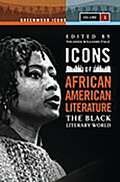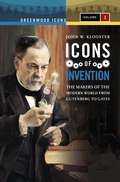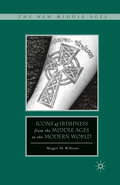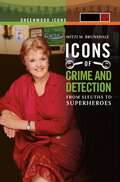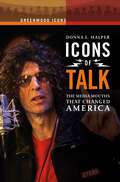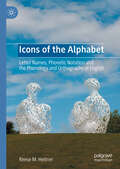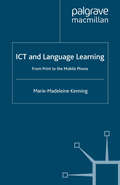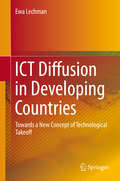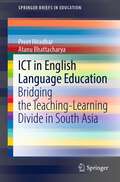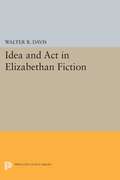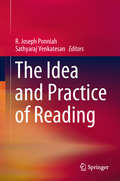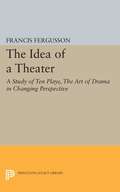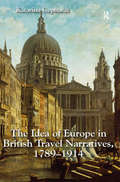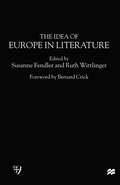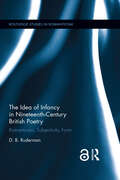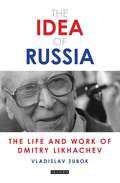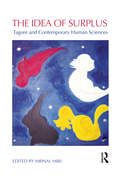- Table View
- List View
Icons of African American Literature: The Black Literary World (Greenwood Icons)
by Yolanda Williams PageThe 24 entries in this book provide extensive coverage of some of the most notable figures in African American literature, such as Alice Walker, Richard Wright, and Zora Neale Hurston.Icons of African American Literature: The Black Literary World examines 24 of the most popular and culturally significant topics within African American literature's long and immensely fascinating history. Each piece provide substantial, in-depth information—much more than a typical encyclopedia entry—while remaining accessible and appealing to general and younger readers.Arranged alphabetically, the entries cover such writers as Maya Angelou, James Baldwin, and August Wilson; major works, such as Invisible Man, Native Son, and Their Eyes Were Watching God; and a range of cultural topics, including the black arts movement, the Harlem Renaissance, and the jazz aesthetic. Written by expert contributors, the essays discuss the enduring significance of these topics in American history and popular culture. Each entry also provides sidebars that highlight interesting information and suggestions for further reading.
Icons of Horror and the Supernatural: An Encyclopedia of Our Worst Nightmares [2 volumes] (Greenwood Icons)
by S. T. JoshiHorror and the supernatural have fascinated people for centuries, and many of the most central figures appear over and over again. These figures have gained iconic status and continue to hold sway over popular culture and the modern imagination. This book offers extended entries on 24 of the most enduring and significant figures of horror and the supernatural, including The Sea Creature, The Witch, The Alien, The Vampire, The Werewolf, The Sorcerer, The Ghost, The Siren, The Mummy, The Devil, and The Zombie. Each entry is written by a leading authority on the subject and discusses the topic's essential features and lasting influence, from the classical epics of Homer to the novels of Stephen King. Entries cite sources for further reading, and the Encyclopedia closes with a selected, general bibliography. Entries include illustrations, sidebars of interesting information, and excerpts from key texts.Horror and the supernatural have fascinated people for centuries, with many of the most central figures appearing over and over again across time and cultures. These figures have starred in the world's most widely read literary works, most popular films, and most captivating television series. Because of their popularity and influence, they have attained iconic status and a special place in the popular imagination. This book overviews 24 of the most significant icons of horror and the supernatural.
Icons of Invention [2 volumes]: The Makers of the Modern World from Gutenberg to Gates [2 volumes] (Greenwood Icons)
by John W. KloosterThese two volumes provide in-depth coverage of 24 of history's most important inventors and their inventions.Who invented the sewing machine, the telephone, the internal combustion engine? Who pioneered vaccination? Who gave the world television, nylon, the nuclear reactor? The answers to some of these questions are straightforward, the answers to others much less so. All of them are explored in the fascinating Icons of Invention: The Makers of the Modern World from Gutenberg to Gates.This in-depth resource tells the stories of 24 of the most influential and well-known inventions of the modern age—and of the individuals most responsible for their development. Presented in chronological order, the entries provide background on the lives and work of inventors such as Thomas Edison, Alexander Fleming, and Tim Berners-Lee. At the same time, the set profiles their competitors and details the sometimes-controversial, often-mistake-plagued routes almost all of them took to their most famous creations.
Icons of Irishness from the Middle Ages to the Modern World (The New Middle Ages)
by M. WilliamsFrom majestic Celtic crosses to elaborate knotwork designs, visual symbols of Irish identity at its most medieval abound in contemporary culture. Consdering both scholarly and popular perspectives this book offers a commentary on the blending of pasts and presents that finds permanent visualization in these contemporary signs.
Icons of Mystery and Crime Detection [2 volumes]: From Sleuths to Superheroes [2 volumes] (Greenwood Icons)
by Mitzi M. BrunsdaleThis book provides an introduction to 24 iconic figures, real and fictional, that have shaped the detective/mystery genre of popular literature.Icons of Mystery and Crime Detection: From Sleuths to Superheroes is an insightful look at one of our most popular and diverse fictional genres, providing a guided tour of mystery and crime writing by focusing on two dozen of the field's most enduring creations and creators.Icons of Mystery and Crime Detection spans the history of the detective story with series of critical entries on the field's most evocative names, from the originator of the form, Edgar Allan Poe, to its first popular running character, Sherlock Holmes; from the Golden Age of Sam Spade, Philip Marlowe, and Charlie Chan—in fiction and films—to small screen heroes, such as Columbo and Jessica Fletcher. Also included are other accomplished practitioners of the craft of mystery/crime storytelling, including Agatha Christie, Tony Hillerman, and Alfred Hitchcock.
Icons of Talk: The Media Mouths That Changed America (Greenwood Icons)
by Donna L. HalperAmericans love talk shows. In a typical week, more than 13 million Americans listen to Rush Limbaugh, whose syndicated radio show is carried by about 600 stations. On television, Oprah Winfrey's syndicated talk show is seen by an estimated 30 million viewers each week. Talk show hosts like Winfrey and Limbaugh have become iconic figures, frequently quoted and capable of inspiring intense opinions. What they say on the air is discussed around the water cooler at work, or commented about on blogs and fan web sites. Talk show hosts have helped to make or break political candidates, and their larger-than-life personalities have earned them millions of fans (as well as more than a few enemies). Icons of Talk highlights the most groundbreaking exemplars of the talk show genre, a genre that has had a profound influence on American life for over 70 years.Among the featured:• Joe Pyne• Jerry Williams• Herb Jepko• Randi Rhodes• Rush Limbaugh• Larry King• Dr. Laura Schlesinger• Steve Allen• Jerry Springer• Howard Stern.• Oprah Winfrey• Don Francisco• Cristina Saralegui• Tavis Smiley• James Dobson• Don ImusGoing behind the scenes, this volume showcases the techniques hosts used to motivate (and sometimes aggravate) audiences, and examines the talk show in all of its various formats, including sports-talk, religious-talk, political-talk, and celebrity-talk. Each entry places the talk format and its hosts into historical context, addressing such questions as: What was going on in society when these talkers were on the air? How did each of them affect or change society? What were the issues they liked to talk about and what reaction did they get from listeners and from critics? How were talk hosts able to persuade people to vote for particular candidates or support certain policies? Which hosts were considered controversial and why? Complete with photographs, a timeline, and a resource guide of sources and organizations, this volume is ideal for students of journalism and media studies.
Icons of the Alphabet: Letter Names, Phonetic Notation and the Phonology and Orthography of English
by Reese M. HeitnerThis book examines the names by which we refer to the letters of the English alphabet, arguing that these letter names provide unrivalled insights into the phonological structure of English, present and past, as well as the many peculiarities of English pronunciation and spelling. Classified either as contronyms, ambinyms or tautonyms, the modern phonological profiles of our ancient Semitic letter names reveal what is unique to English, what is fundamental to language and how letter names emerge as the semiotic product of interchanging languages combined with intralanguage change. This volume promises a much more extensive and deeper linguistic treatment of English letter names than has previously been attempted. It will be of particular interest to students and scholars of historical linguistics, phonology and orthography, the history of English, semiotics, and language and literacy teaching.
ICT and Language Learning: From Print to the Mobile Phone
by M. KenningThis book explores the interplay of ICT and language learning within the context of technological and social change, from the printing press to the mobile phone. It considers how technological advances, through their impact on communication, language and education, affect not only how languages are learnt, but also what kind of language is learnt.
ICT Diffusion in Developing Countries: Towards a New Concept of Technological Takeoff
by Ewa LechmanThis book provides an extensive overview of the diffusion of Information and Communication Technologies (ICTs) in developing countries between 2000 and 2012. It covers issues such as country-specific ICT diffusion patterns, technological substitution and technological convergence. By identifying social, economic and institutional prerequisites and analyzing critical country-specific conditions, the author develops a new approach to explaining the emergence of their technological takeoff. Readers will discover how developing countries are now adopting ICTs, rapidly catching up with the developed world in terms of ICT access and use.
ICT in English Language Education: Bridging the Teaching-Learning Divide in South Asia (SpringerBriefs in Education)
by Preet Hiradhar Atanu BhattacharyaThis book discusses the use of Web 2.0 tools to leverage students’ own use of New Media, which can take learning beyond the classroom. This paradigmatic book will help language educators gain a better understanding of the shift in pedagogic practices through the incorporation of technology in language learning programs. It explores the theoretical underpinnings of ICT in education, before moving on to pragmatic considerations and subsequent implementation of ICT within and beyond language classrooms in the South Asian context. The book covers a wide range of topics, such as the context within which ICT can be placed vis-à-vis teaching and learning in the digital age, as well as the role of ICT in communicative practices, and strategies used to bring these practices to the language classroom. It illustrates how ICT can be incorporated for both receptive as well as productive language learning skills, such as listening, reading, speaking, and writing within pedagogic frameworks. Accordingly, it addresses affordable technologies and how they can be made a part of the teaching–learning experience. Finally, in terms of ICT beyond the classroom, the book provides a broader perspective on ICT in terms of selecting platforms or software, as well as the evaluation of ICT with special reference to ICT policies that offer language educators guidance on managing ICT frameworks within their institutions. Given its scope, the book offers a valuable asset for language educators, teacher trainers, students, and researchers in education and linguistics programs within and outside South Asia.
Idea and Act in Elizabethan Fiction
by Walter R. DavisRepresents an attempt to apply the techniques of modern literary criticism to the fiction of the Elizabethan period. The author tries "to determine what Elizabethan fiction writers were trying to do and how they did it."Originally published in 1969.The Princeton Legacy Library uses the latest print-on-demand technology to again make available previously out-of-print books from the distinguished backlist of Princeton University Press. These editions preserve the original texts of these important books while presenting them in durable paperback and hardcover editions. The goal of the Princeton Legacy Library is to vastly increase access to the rich scholarly heritage found in the thousands of books published by Princeton University Press since its founding in 1905.
The Idea and Practice of Reading
by R. Joseph Ponniah Sathyaraj VenkatesanThis book addresses basic issues in language education and explores how reading, with a focus on meaning, contributes to the development of all aspects of language including vocabulary, spelling, grammar, and syntax. It departs from traditional methods and practices in language learning to investigate the potency of reading in improving language acquisition. The traditional practice in language classes to teach language skills explicitly through acquiring forms and structures of language is often less than successful, and teachers are gradually incorporating reading materials and practices into the curriculum. This book provides important inputs to language teachers and educators on the need to include reading as an idea and as a practice into the curriculum. Among other things, it explores the benefits of incidental learning of language properties such as vocabulary, syntax and grammar and gives adequate exposure to different types of reading strategies to promote reading among learners. It also exploits the possible transfer of L1 reading strategies and capabilities to L2 reading for language acquisition. In so doing, this book hopes to promote autonomous learning among L2 learners and guide readers in alternative strategies to solve comprehension problems.
The Idea of a Theater: A Study of Ten Plays, The Art of Drama in Changing Perspective
by Francis FergussonAn original and beautifully written book on changing perspectives in the art of theater. Through a study of nine plays—Oedipus Rex, Bérénice, Tristan und Isolde, Hamlet, Ghosts, The Cherry Orchard, Six Characters in Search of an Author, Noah, Murder in the Cathedral—the author shows how all playwrights seek to "hold the mirror up to nature" and how in this respect the art of drama is always the same, varying only with the philosophical and aesthetic concepts of each age. The Idea of a Theater will delight both readers with a special interest in drama and those who read drama as a source of insight into man's nature and man’s changing ideas of himself.Originally published in 1949.The Princeton Legacy Library uses the latest print-on-demand technology to again make available previously out-of-print books from the distinguished backlist of Princeton University Press. These editions preserve the original texts of these important books while presenting them in durable paperback and hardcover editions. The goal of the Princeton Legacy Library is to vastly increase access to the rich scholarly heritage found in the thousands of books published by Princeton University Press since its founding in 1905.
The Idea of Anglo-Saxon England 1066-1901: Remembering, Forgetting, Deciphering, and Renewing the Past
by John D. NilesThe Idea of Anglo Saxon England, 1066-1901 presents the first systematic review of the ways in which Anglo-Saxon studies have evolved from their beginnings to the twentieth century Tells the story of how the idea of Anglo-Saxon England evolved from the Anglo-Saxons themselves to the Victorians, serving as a myth of origins for the English people, their language, and some of their most cherished institutions Combines original research with established scholarship to reveal how current conceptions of English identity might be very different if it were not for the discovery – and invention – of the Anglo-Saxon past Reveals how documents dating from the Anglo-Saxon era have greatly influenced modern attitudes toward nationhood, race, religious practice, and constitutional liberties Includes more than fifty images of manuscripts, early printed books, paintings, sculptures, and major historians of the era
The Idea of Anglo-Saxon England 1066-1901: Remembering, Forgetting, Deciphering, and Renewing the Past
by John D. NilesThe Idea of Anglo Saxon England, 1066-1901 presents the first systematic review of the ways in which Anglo-Saxon studies have evolved from their beginnings to the twentieth century Tells the story of how the idea of Anglo-Saxon England evolved from the Anglo-Saxons themselves to the Victorians, serving as a myth of origins for the English people, their language, and some of their most cherished institutions Combines original research with established scholarship to reveal how current conceptions of English identity might be very different if it were not for the discovery – and invention – of the Anglo-Saxon past Reveals how documents dating from the Anglo-Saxon era have greatly influenced modern attitudes toward nationhood, race, religious practice, and constitutional liberties Includes more than fifty images of manuscripts, early printed books, paintings, sculptures, and major historians of the era
The Idea of Culture (Wiley-Blackwell Manifestos #19)
by Terry EagletonTerry Eagleton's book, in this vital new series from Blackwell, focuses on discriminating different meanings of culture, as a way of introducing to the general reader the contemporary debates around it.
The Idea of Education in Golden Age Detective Fiction (Literature and Education)
by Andrew Green Roger DalrympleThis book presents an exploration of how Golden Age detective fiction encounters educational ideas, particularly those forged by the transformative educational policymaking of the interwar period.Charting the educational policy and provision of the era, and referring to works by Agatha Christie, Dorothy L. Sayers, Edmund Crispin and others, this book explores the educational capacity and agency of literary detectives, the learning spaces of the genre and the kinds of knowledge that are made available to inquirers both inside and outside the text. It is argued that the genre explores a range of contemporaneous propositions on the balance between academic curriculum and practicum, length of school life and the value of lifelong learning. This book’s closing chapter considers the continuing pedagogic value for contemporary classrooms of engaging with the genre as a rich discursive and imaginative space for exploring educational ideas.Framing Golden Age detective fiction as a genre profoundly concerned with learning, this book will be highly relevant reading for academics, postgraduate students and scholars involved in the fields of English language arts, twentieth-century literature and the theories of learning more broadly. Those interested in detective fiction and interdisciplinary literary studies will also find the volume of interest.
The Idea of Education in Golden Age Detective Fiction (Literature and Education)
by Andrew Green Roger DalrympleThis book presents an exploration of how Golden Age detective fiction encounters educational ideas, particularly those forged by the transformative educational policymaking of the interwar period.Charting the educational policy and provision of the era, and referring to works by Agatha Christie, Dorothy L. Sayers, Edmund Crispin and others, this book explores the educational capacity and agency of literary detectives, the learning spaces of the genre and the kinds of knowledge that are made available to inquirers both inside and outside the text. It is argued that the genre explores a range of contemporaneous propositions on the balance between academic curriculum and practicum, length of school life and the value of lifelong learning. This book’s closing chapter considers the continuing pedagogic value for contemporary classrooms of engaging with the genre as a rich discursive and imaginative space for exploring educational ideas.Framing Golden Age detective fiction as a genre profoundly concerned with learning, this book will be highly relevant reading for academics, postgraduate students and scholars involved in the fields of English language arts, twentieth-century literature and the theories of learning more broadly. Those interested in detective fiction and interdisciplinary literary studies will also find the volume of interest.
The Idea of Europe in British Travel Narratives, 1789-1914
by Katarina GephardtThe nineteenth century was the heyday of travel, with Britons continually reassessing their own culture in relation to not only the colonized but also other Europeans, especially the ones that they encountered on the southern and eastern peripheries of the continent. Offering illustrative case studies, Katarina Gephardt shows how specific rhetorical strategies used in contemporary travel writing produced popular fictional representations of continental Europe in the works of Ann Radcliffe, Lord Byron, Charles Dickens, and Bram Stoker. She examines a wide range of autobiographical and fictional travel narratives to demonstrate that the imaginative geographies underpinning British ideas of Europe emerged from the spaces between fact and fiction. Adding texture to her study are her analyses of the visual dimensions of cross-cultural representation and of the role of evolving technologies in defining a shared set of rhetorical strategies. Gephardt argues that British writers envisioned their country simultaneously as distinct from the Continent and as a part of Europe, anticipating the contradictory British discourse around European integration that involves both fear that the European super-state will violate British sovereignty and a desire to play a more central role in the European Union.
The Idea of Europe in British Travel Narratives, 1789-1914
by Katarina GephardtThe nineteenth century was the heyday of travel, with Britons continually reassessing their own culture in relation to not only the colonized but also other Europeans, especially the ones that they encountered on the southern and eastern peripheries of the continent. Offering illustrative case studies, Katarina Gephardt shows how specific rhetorical strategies used in contemporary travel writing produced popular fictional representations of continental Europe in the works of Ann Radcliffe, Lord Byron, Charles Dickens, and Bram Stoker. She examines a wide range of autobiographical and fictional travel narratives to demonstrate that the imaginative geographies underpinning British ideas of Europe emerged from the spaces between fact and fiction. Adding texture to her study are her analyses of the visual dimensions of cross-cultural representation and of the role of evolving technologies in defining a shared set of rhetorical strategies. Gephardt argues that British writers envisioned their country simultaneously as distinct from the Continent and as a part of Europe, anticipating the contradictory British discourse around European integration that involves both fear that the European super-state will violate British sovereignty and a desire to play a more central role in the European Union.
The Idea of Europe in Literature (University of Durham/Macmillan)
by Susanne Fendler Ruth WittlingerThe relevance of culture has recently enjoyed increasing recognition for the study of European integration and a European identity. Appeals to a common European culture as well as appeals to different national cultures have been used respectively as a means to pursue political ends. Paying tribute to literature's role as an important constituent part of a culture, this collection of essays explores literary representations of Europe and its nation states and should be of particular value to anyone who is interested in cultural, political or literary studies in the European context.
The Idea of Infancy in Nineteenth-Century British Poetry: Romanticism, Subjectivity, Form (Routledge Studies in Romanticism)
by D.B. RudermanThis book radically refigures the conceptual and formal significance of childhood in nineteenth-century English poetry. By theorizing infancy as a poetics as well as a space of continual beginning, Ruderman shows how it allowed poets access to inchoate, uncanny, and mutable forms of subjectivity and art. While recent historicist studies have documented the "freshness of experience" childhood confers on 19th-century poetry and culture, this book draws on new formalist and psychoanalytic perspectives to rethink familiar concepts such as immortality, the sublime, and the death drive as well as forms and genres such as the pastoral, the ode, and the ballad. Ruderman establishes that infancy emerges as a unique structure of feeling simultaneously with new theories of lyric poetry at the end of the eighteenth century. He then explores the intertwining of poetic experimentation and infancy in Wordsworth, Anna Barbauld, Blake, Coleridge, Erasmus Darwin, Sara Coleridge, Shelley, Matthew Arnold, Tennyson, and Augusta Webster. Each chapter addresses and analyzes a specific moment in a writers’ work, moments of tenderness or mourning, birth or death, physical or mental illness, when infancy is analogized, eulogized, or theorized. Moving between canonical and archival materials, and combining textual and inter-textual reading, metrical and prosodic analysis, and post-Freudian psychoanalytic theory, the book shows how poetic engagements with infancy anticipate psychoanalytic and phenomenological (i.e. modern) ways of being in the world. Ultimately, Ruderman suggests that it is not so much that we return to infancy as that infancy returns (obsessively, compulsively) in us. This book shows how by tracking changing attitudes towards the idea of infancy, one might also map the emotional, political, and aesthetic terrain of nineteenth-century culture. It will be of interest to scholars in the areas of British romanticism and Victorianism, as well as 19th-century American literature and culture, histories of childhood, and representations of the child from art historical, cultural studies, and literary perspectives. "D. B. Ruderman’s The Idea of Infancy in Nineteenth-Century British Poetry: Romanticism, Subjectivity, Form is an interesting contribution to this field, and it manages to bring a new perspective to our understanding of Romantic-era and Victorian representations of infancy and childhood. …a supremely exciting book that will be a key work for generations of readers of nineteenth-century poetry." Isobel Armstrong, Birkbeck, University of London Victorian Studies (59.4)
The Idea of Infancy in Nineteenth-Century British Poetry: Romanticism, Subjectivity, Form (Routledge Studies in Romanticism)
by D.B. RudermanThis book radically refigures the conceptual and formal significance of childhood in nineteenth-century English poetry. By theorizing infancy as a poetics as well as a space of continual beginning, Ruderman shows how it allowed poets access to inchoate, uncanny, and mutable forms of subjectivity and art. While recent historicist studies have documented the "freshness of experience" childhood confers on 19th-century poetry and culture, this book draws on new formalist and psychoanalytic perspectives to rethink familiar concepts such as immortality, the sublime, and the death drive as well as forms and genres such as the pastoral, the ode, and the ballad. Ruderman establishes that infancy emerges as a unique structure of feeling simultaneously with new theories of lyric poetry at the end of the eighteenth century. He then explores the intertwining of poetic experimentation and infancy in Wordsworth, Anna Barbauld, Blake, Coleridge, Erasmus Darwin, Sara Coleridge, Shelley, Matthew Arnold, Tennyson, and Augusta Webster. Each chapter addresses and analyzes a specific moment in a writers’ work, moments of tenderness or mourning, birth or death, physical or mental illness, when infancy is analogized, eulogized, or theorized. Moving between canonical and archival materials, and combining textual and inter-textual reading, metrical and prosodic analysis, and post-Freudian psychoanalytic theory, the book shows how poetic engagements with infancy anticipate psychoanalytic and phenomenological (i.e. modern) ways of being in the world. Ultimately, Ruderman suggests that it is not so much that we return to infancy as that infancy returns (obsessively, compulsively) in us. This book shows how by tracking changing attitudes towards the idea of infancy, one might also map the emotional, political, and aesthetic terrain of nineteenth-century culture. It will be of interest to scholars in the areas of British romanticism and Victorianism, as well as 19th-century American literature and culture, histories of childhood, and representations of the child from art historical, cultural studies, and literary perspectives. "D. B. Ruderman’s The Idea of Infancy in Nineteenth-Century British Poetry: Romanticism, Subjectivity, Form is an interesting contribution to this field, and it manages to bring a new perspective to our understanding of Romantic-era and Victorian representations of infancy and childhood. …a supremely exciting book that will be a key work for generations of readers of nineteenth-century poetry." Isobel Armstrong, Birkbeck, University of London Victorian Studies (59.4)
The Idea of Russia: The Life and Work of Dmitry Likhachev (Library of Modern Russia)
by Vladislav ZubokDmitry Likhachev (1906-1999) was one of the most prominent Russian intellectuals of the twentieth century. His life spanned virtually the entire century – a tumultuous period which saw Russia move from Tsarist rule under Nicholas II via the Russian Revolution and Civil War into seven decades of communism followed by Gorbachev's Perestroika and the rise of Putin. In 1928, shortly after completing his university education, Likhachev was arrested, charged with counter-revolutionary ideas and imprisoned in the Gulag, where he spent the next five years. Returning to a career in academia, specialising in Old Russian literature, Likhachev played a crucial role in the cultural life of twentieth-century Russia, campaigning for the protection of important cultural sites and historic monuments. He also founded museums dedicated to great Russian writers including Dostoevsky, Pushkin and Pasternak. In this, the first biography of Likhachev to appear in English, Vladislav Zubok provides a thoroughly-researched account of one of Russia's most extraordinary and influential public figures.
The Idea of Surplus: Tagore and Contemporary Human Sciences
by Mrinal MiriThis book provides an analytical understanding of some of Tagore’s most contested and celebrated works and ideas. It reflects on his critique of nationalism, aesthetic worldview, and the idea of ‘surplus in man’ underlying his life and works. It discusses the creative notion of surplus that stands not for ‘profit’ or ‘value’, but for celebrating human beings’ continuous quest for reaching out beyond one’s limits. It highlights, among other themes, how the idea of being ‘Indian’ involves stages of evolution through a complex matrix of ideals, values and actions—cultural, historical, literary and ideological. Examining the notion of the ‘universal’, contemporary scholars come together in this volume to show how ‘surplus in man’ is generated over the life of concrete particulars through creativity. The work brings forth a social scientific account of Tagore’s thoughts and critically reconstructs many of his epochal ideas. Lucid in analysis and bolstered with historical reflection, this book will be a major intervention in understanding Tagore’s works and its relevance for the contemporary human and social sciences. It will interest scholars and researchers of philosophy, literature and cultural studies.
